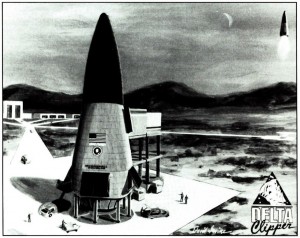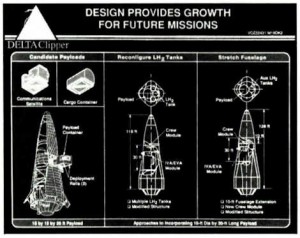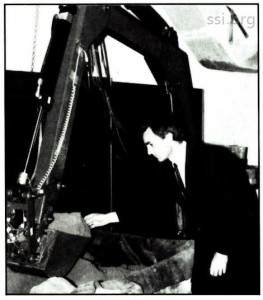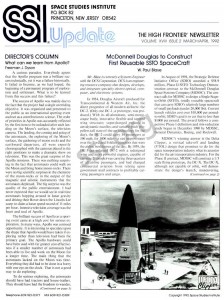
SPACE STUDIES INSTITUTE
P.O. BOX 82
PRINCETON, NEW JERSEY 08542
[[librarian note: This address is here, as it was in the original printed newsletter, for historical reasons. It is no longer the physical address of SSI. For contributions, please see this page]]
SSI UPDATE
THE HIGH FRONTIER® NEWSLETTER
VOLUME XVIII ISSUE 2 MARCH/APRIL 1992
DIRECTOR’S COLUMN
What can we learn from Apollo?
Freeman J. Dyson
A curious paradox. Everybody agrees that the Apollo program was a brilliant success technically, yet it was a failure historically. It failed to become, as we had hoped, the beginning of a permanent program of exploration and settlement. What is to be learned from this success and this failure?
The success of Apollo was mainly due to the fact that the project had a single overriding objective. It was organized and presented to the public as an international sporting event and not as a contribution to science. The order of priorities in Apollo was accurately reflected by the first item to be unloaded after each landing on the Moon’s surface, the television camera. The landing, the coming and going of the astronauts, the exploring of the Moon’s surface, the gathering of moon rocks and the earthward departure, all were expertly choreographed with the cameras placed in the right positions to make a dramatic show on television. This was the great surprise of the Apollo missions. There was nothing surprising in the fact that astronauts could walk on the Moon and bring home moon-rocks. There were no big scientific surprises in the chemistry of the moon-rocks or in the output of the magnetic and seismic instruments that the astronauts deployed. The big surprise was the quality of the public entertainment. I had never expected that we would see in real time astronauts hopping around in lunar gravity and driving their Rover down the Lincoln-Lee scarp to claim a lunar speed record of 11 miles per hour. Intensive television coverage was the heart and soul of Apollo.
The brilliant success of Apollo as a sporting event came at a high cost for serious exploration. In many ways, Apollo was a missed opportunity. It is interesting to speculate upon the shape that Apollo would have taken if exploring rather than television had been the primary goal. The Apollo hardware could have been used with far greater cost-effectiveness if a smaller number of astronauts had been able to live and work on the Moon for a longer time. The main thing that the astronauts lacked on the Moon was time. Everything they did had to be done in a hurry with one eye on the clock. That is not a good way to do exploring.
To do serious exploring, the astronauts should have had tractors and housetrailers. They should have had the freedom to wander, to dig, to analyze, to think, or to sit around doing nothing. A mobile laboratory building was envisaged in the early plans for Apollo but never reached the Moon.
Let us take a rough look at the numbers, to see how the Apollo payloads were used and how they might have been used. There were six lunar landings. Each of the six completed missions put roughly 50 tons into orbit about the Moon. Each mission was self-contained and allowed two astronauts to spend up to three days on the Moon, a total of 36 mandays for exploration and science. Of the 50 tons in lunar orbit, 35 tons were used to return to Earth, 15 tons to land on the Moon and return to orbit. Of the 15 tons that descended from lunar orbit, five were needed for the return to orbit and two were used for lifesupport and transportation and exploration on the Moon. So the Apollo missions used about 12 tons of payload on the Moon for about 36 man-days of activity. This was extremely inefficient use of resources. It makes no sense scientifically to bring a roving vehicle to the Moon and then use it only for three days.
Apollo achieved three man-days per ton of payload on the Moon. I do not know how many man-days per ton you could achieve in a well-planned expedition. Wernher von Braun had given some thought to this problem when he planned his “Mars Project” in 1952. He planned to have 50 people exploring Mars for 400 days with a total payload of 150 tons on Mars. That works out at 130 man-days per ton. Perhaps 130 man-days per ton would mean uncomfortably Spartan conditions. People could certainly live comfortably on 40 man-days per ton, which is 13 times the endurance of Apollo. Beyond this, we could have achieved another factor of five improvement in the cost-effectiveness of Apollo by using half the missions for passengers and half for freight. This was the way von Braun planned his logistics for the trip to Mars. Three Apollo missions could have been passenger missions, bringing two astronauts each to the Moon and back, while the other three could have been unmanned freight missions. Each freight mission, starting with 50 tons in lunar orbit, could have made a soft landing on the Moon with 18 tons of payload. In this way the useful payload on the Moon could have been increased from 12 to 60 tons, while the number of astronauts was reduced from 12 to 6.
Finally, if we had six astronauts land on the Moon with 60 tons of payload, and if we assume they could live for 40 man-days per ton, then they could all stay on the Moon together for 400 days, just as long as von Braun’s team was supposed to stay on Mars. This would have given them a chance to do some real exploring.
Provided with a mobile habitat and traveling only 15 miles per day, they could have circumnavigated the Moon, passing over both poles and traversing the back side. They might have been lucky enough to find a supply of native ice frozen in the perpetually shaded bottoms of the polar craters. A patch of what appears to be ice was recently found at the North pole of Mercury, giving a very strong reflection of radar signals transmitted from Goldstone in California and received at Socorro in New Mexico. If ice can survive on Mercury, ice should also be able to survive on the Moon. If the Moon explorers had found a local supply of water, they could have lengthened their stay beyond 400 days and could have prepared the ground for a permanent lunar settlement. All this might have been done within the budget and time-span of Apollo. It was a great opportunity missed. Instead, we had some good shows on the television.
This hypothetical version of Apollo, with six people on the ground for a year, could have done a good job of exploring the Moon. Much less than this would be inadequate to the task; much more would have been impossibly expensive. Apollo was not too small or too big for its mission. Its historical failure had little to do with size. Its technical success and its historical failure both arose from the fact that exploring was not its primary purpose. The missions beyond Apollo 18 were cancelled and the project brought to a halt, because the purpose of public entertainment had been achieved, and further repetitions of the same landing-and-takeoff spectacle would not have added much to the quality of the show. From the point of view of exploring, further missions following the same three-day pattern would have been valuable, but not valuable enough to justify their cost.
The opportunity to do cost-effective exploring of the Moon was missed. But not forever. The opportunity is still open, whenever humanity may decide the time is ripe for a big new effort of exploring. Next time, if we do it right, we will have good exploring and good television too. And next time we will have other technical tricks that the old Apollo lacked. We will have chemical and physical processes for converting lunar soil into building materials and rocket-fuel, and we will have mass-drivers for getting stuff off the Moon into lunar orbit. These tricks will increase the cost-effectiveness of lunar exploring by another big factor, thanks to the patient development work that has been done with modest resources under the auspices of SSI.
Freeman Dyson is a professor in the School of Natural Sciences at the Institute of Advanced Study.
McDonnell Douglas to Construct First Reusable SSTO Spacecraft
W. Paul Blase
Mr. Blase is currently a Systems Engineer with the DCS Corporation. DCS is an engineering resource company that designs, develops, and integrates specialty electro-optical, computer, and electronic systems.
In 1934, Douglas Aircraft produced for Transcontinental & Western Air, Inc. the direct progenitor of all modern airliners: the DC-2. (Only one DC-1, a prototype, was produced.) With its all-aluminum, semi-monocoque body; innovative flexible and tapered wing structure; supercharged engines in aerodynamic nacelles; and variable-pitch propellers (all state-of-the-art technology for the day), the DC-2 could carry 14 passengers at 196 mph, for 1800 miles – a vast improvement over the Ford and Fokker trimotors that were the airline workhorses of the day. By 1939, the DC-3 (an enlarged DC-2 with a redesigned wing and more powerful engines, capable of carrying 21 people) was carrying three-quarters of all airline passengers, and had changed commercial aviation from relying upon government mail contracts to profitably carrying passengers and cargo.
In August of 1991, the Strategic Defense Initiative Office (SDIO) awarded a $58.9 million, Phase II SSTO Technology Demonstration contract to the McDonnell Douglas Space Systems Company (MDSSC). The contract calls for MDSSC to design a Single-Stage-to-Orbit (SSTO), totally reusable spacecraft that can carry SDIO’s relatively large numbers of small payloads (under 20,000 lbs). Current launch vehicles cost over $10,000 per poundto-orbit; SDIO’s goal is to cut that to less than $1000 per pound. The award follows a competitive Phase I definition and risk-reduction study begun in December 1990 by MDSSC, General Dynamics, Boeing, and Rockwell.
MDSSC’s winning answer is the Delta Clipper, a vertical take-off and landing (VTOL) design that promises to do for the space transportation industry what its ancestor did for the air transportation industry. For the Phase II contract, MDSSC will construct a 1/3 scale flying prototype, the DC-X. The DC-X, although not capable of orbit, will demonstrate the design’s launch, maneuvering, hovering, and landing capabilities.
If Phase II is successful, then during Phase III of the SSTO project, to last from 1993 through 1996, MDSSC will design, construct, and test the DC-Y, a full-scale, orbit capable prototype. Finally, during Phase IV MDSSC will design – for first launch sometime during 1999 – the production version of the Delta Clipper (designated, not accidentally, the DC-1).
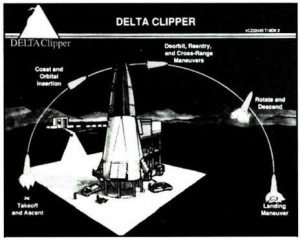
To provide the wide range of expertise necessary, MDSSC has formed a wide-ranging team of aerospace companies. MDSSC (itself a subsidiary of McDonnell Douglas) is performing system engineering and project management; Aerojet GenCorp and Pratt & Whitney are developing the engines; Messerschmitt-Bolkow-Blohm is designing the landing gear and providing general reusable systems and VTOL experience; Martin Marietta is providing experience in cryogenic ground operations and NASP-derived technology; two other McDonnell Douglas subsidiaries, Douglas Aircraft Corporation and McDonnell Aircraft (MCAIR), are providing commercial and high-performance military aircraft technology; and a large group of other subcontractors bring expertise in various space systems.
The full-scale Delta Clipper will stand 127 feet high and 30 feet wide at the base, weigh approximately 80,000 pounds empty, carry 20,000 pounds of cargo, and burn 940,000 pounds of liquid hydrogen and oxygen through a ring of engines in its base. The DC-X will use four modified Pratt & Whitney RL-10A-4 bellnozzle engines. MDSSC has not decided upon the exact configuration for the DC-Y yet; either multiple bell-nozzled engines (10 or 12) or a variation on the Rocketdyne-developed “aerospike” engine may be used.
In a dramatic departure from earlier SSTO designs, which descended tail-first in a manner very similar to an Apollo capsule, the Delta Clipper reenters the atmosphere nosefirst, at a high angle of attack. The Delta Clipper’s shape is, in fact, a supersonic lifting body/flying wing capable of 1600 miles of cross-range maneuvering during reentry. Four extendable control surfaces around the base, along with maneuvering thrusters, provide control in the atmosphere. Once the craft has reached (approximately) 20,000 feet and 180 knots, the engines ignite and idle, and the nose is pulled up so that the craft is vertical with its base downward. The engines are then throttled up and the craft hovers, descends, extends the landing gear, and lands. A landing pad less than 300 feet in diameter is all that is required.
Although the National Aerospace Plane program (NASP), will not construct the hypersonic X-30 for several years yet, the Delta Clipper may truly be called the first NASP derivative. The Delta Clipper draws heavily upon NASP for advanced composite materials for its structure and fuel tanks, new thermal shielding materials, and thermal & aerodynamic computer simulation software.
The structural truss of the Clipper is graphite/epoxy; the skin is graphite/epoxy and aluminum in a honeycomb sandwich, and carbon-carbon and carbon-silicon carbide insulation shield the Clipper from the heat of reentry. The landing gear is made out of titanium-silicon carbide composite; the liquid hydrogen (LH) tank is graphite/epoxy; and the liquid oxygen (LOX) tank is made from a new aluminum-copper-lithium alloy.
MDSSC intends for the Clipper to operate much like a modern commercial aircraft. Airlines do not tear a jet apart after each flight. Rather, aircraft receive specific minimal maintenance and overhauls at regular intervals.
As part of this “airliner” approach to space operations, MDSSC is currently working with the FAA to develop a set of criteria for fleet-certifying the Delta Clipper, in almost exactly the same way that airliners are certified. This certification requires MDSSC to design the vehicle to operate within a given set of margins with respect to thermal and mechanical loads, and to incorporate aerodynamic controls capable of handling the entire span of normal and abnormal flight conditions. It also covers all of the craft’s maintenance and support infrastructure so that for each flight the operator can be assured that the vehicle is flying within margins that meet the vehicle certification.
Like an airliner, the Clipper is being designed for safety. During takeoff, it will be able to achieve orbit if two engines fail and will be able to safely land on half of them. If an emergency landing is necessary, it will be capable of landing in any flat area after hovering to burn off fuel. The Clipper is being designed to airline standards for all-weather capability, and will be able to land under the 43 knot sharp-edged wind gust conditions required by the FAA for commercial aircraft.
Another important cost-reducing feature is flexibility. In an interesting twist, the Delta Clipper’s cargo is carried not in the nose of the craft (a traditional location), but in two bays in the center, with LH and LOX tanks above and below. Each bay contains a mission module that may, in turn, contain either crew or cargo. The Clipper may fly unmanned with two cargo modules, say for a routine satellite launch or space station resupply mission. If a manned mission is required, one module would contain a crew/control cabin; the other may then contain either cargo, a pressurized working module, or a remote manipulator arm similar to the one used in the Shuttle. Externally, the modules are all identical, having standardized connections to the Clipper for power, cooling, and the control interface. A customer can take as long as it likes to fit a cargo into a module and then launch it on the next available Clipper.
Adding to this flexibility is the fact that since the Clipper does not drop stages after launch, and because of its inherent reliability, it need not be launched from coastal sites. Since the craft ascends vertically for the first part of the launch, like any rocket, noise pollution is kept to a minimum and the launch sites could be incorporated into existing airports. It also, incidentally, means that to move a Clipper from one launch site to another, no carrier vehicle is necessary: the craft just does a suborbital hop.
Finally, MDSSC’s design for the Delta Clipper reduces costs by reducing the amount of work and equipment required to prepare the craft for launch. MDSSC is specifying a 20year lifetime for the structure of the Clipper, and a minimum of 200 launches between major overhauls on the engines. The engines can easily be pulled for servicing, and all of the line-replaceable-units (primarily avionics) that need the most maintenance are easily accessed via the cargo bays.
The Delta Clipper does not require a complex launch facility or gantry; the launch pad consists of flame ducts and support pylons (the landing gear cannot support a fully-fueled vehicle). However, the cryogenic fuel-handling equipment is built into the pad and the refueling operation will be made as automatic as possible. No special vehicles or facilities will be required to service the Clipper or to load the cargo modules; everything can be done on the pad with ordinary scissor-jack trucks. MDSSC predicts that the Delta Clipper can be turned around in less than a week.
An important result of this reduction in turnaround time is that the number of people required to operate the Clipper is greatly reduced. To paraphrase one of the aerospace people interviewed for this article: adding hardware to project increases its cost linearly; adding people increases the costs exponentially. The Shuttle requires over 40,000 people to prepare it for launch. The Delta Clipper will require on the order of 600, including administrative personnel – a number comparable to that required for a commercial aircraft.
Like the DC-2 and DC-3 before it, the Delta Clipper promises to transform an industry. By taking advantage of the latest technology, yet insisting that this technology be proven, and by insisting that the reduction of operational costs be a major design criteria, McDonnell Douglas stands a good chance of accomplishing its goal of creating a spacecraft that can be operated as efficiently as a commercial airliner.
SSI RESEARCH UPDATE
The following updates were submitted by the respective researchers. “SSI Update” will publish short summaries of current research on a quarterly basis, in addition to its feature articles.
Status Report on the SSI/McDonnell Douglas/Alcoa Lunar Resource Processing Project
John Garvey
Work is continuing on the joint SSI/McDonnell Douglas/Alcoa Lunar Resource Processing project, although at a slower pace than the participants would like due to the current tight fiscal environment. Recently, an important milestone was achieved when Alcoa shipped a crucible mounting structure to McDonnell Douglas’ solar concentrator test facility in Huntington Beach, CA. This structure will support the second generation melt crucible that Alcoa fabricated last year.
McDonnell Douglas is now finishing several other modifications to the 75kW solar concentrator that include the incorporation of drive mechanisms for controlling the melt crucible’s position and angle with respect to the concentrator’s focus point and the local vertical. This work should be finished by late March, at which point preliminary testing of the crucible will begin. Hopefully, by that time the California weather will have returned to a semblance of sunny, cloudless skies that once characterized that part of the country.
The concentrator/crucible configuration should provide researchers the ability to conduct two-step processing in which lunar simulant is first melted in the crucible and then either transferred to a mold for controlled cooling into cast basalt products, or through a platinum/rhodium bushing to create glass fibers that might find applications in glass-glass composites. This phased approach represents a major improvement over the previous method of melting and then cooling the simulant in the same container and is similar to techniques used in terrestrial foundries.
After verifying the crucible’s utility, McDonnell Douglas will then coordinate cooperative research with Glass Strand, Inc. (GSI), which is developing a thermal control valve under a Phase I Small Business Innovative Research contract from NASA’s Johnson Space Center. GSI is a small company with expertise in glass fiber production that Brandt Goldsworthy (SSI Director, former president of Alcoa/Goldsworthy Engineering, and now a consultant to Alcoa) recruited for the lunar resource processing project. This valve will enable much more precise control over the melt flow and hence should result in improved end products.
Robotic Manipulator
Leonhard Bernold
Since moving from the University of Maryland to the North Carolina State University, I have been working on two separate issues related to space engineering and construction. Firstly, a major part of my time went into the development of a new research facility dedicated to automation and robotics in construction. The provided photograph shows one of the unique computer controlled systems, the multipurpose robotic manipulator platform (MRMP). Equipped with many sensory devices and four hydraulic actuators, the system will serve as the key tool to study robotic excavation on the Moon and on Mars. The support provided by the Space Studies Institute is crucial for the development of this very special research tool in that it allows me to add new capabilities (e.g., sensors) when needed. I hope that it will be possible in the future to fund an excellent graduate research student who has shown a strong interest in writing a PhD. thesis in the area of robotic control of excavation using the established equipment.
My second effort concentrated on initiating and heading a new committee sponsored by the American Society of Civil Engineers. The mission of this new committee is to foster the role of Civil Engineers in Space Education. One of our main projects is the organization of a national student contest to design and remotely construct a scaled down lunar shelter. The contest will be held for the first time in 1994 during SPACE 94, Engineering and Construction in Space. Here again, the support of the Space Studies Institute provided the resources for me to attend a meeting where my initiative was discussed and accepted. It is doubtful that this Space Education committee would exist today without the contribution provided by SSI. If you are interested in joining our efforts, please contact me at xxx-xxx-xxxx.
Senior Associates that participate in a Matching Gifts program, which will only match donations made to degree-granting institutions, can help fund Dr. Bernold’s work at the North Carolina State University. For details, please contact Bettie Greber at the SSI office.
Lunar Electrolysis By EMEC Consultants
Rudolf Keller
In 1986, EMEC Consultants started the development of a process to produce silicon, aluminum, calcium and oxygen from lunar anorthite, a calcium aluminum silicate readily available in copious quantities in Highland soil. The anorthite is dissolved in a fluoride melt and silicon reduced by aluminum metal in the first major process step.
Aluminum, calcium and oxygen are then produced by electrolysis in the other major process step. The process is designed to yield silicon for the manufacture of solar cells.
Recently, the process concept was modified to focus on the production of oxygen, to be feasible with feed of a broad variety of lunar oxides with no or only minor beneficiation. The ore is again dissolved in a fluoride melt, then electrolyzed at about 1000°C to oxygen at the anode and a mixture of metals, corresponding to the ore composition, at the cathode. Present efforts are concentrating on the study of suitable anodes which produce oxygen but remain stable during electrolysis. The separation of the cathode metals is another topic of present investigations.
Without a fused salt flux, lunar silicates can be melted and directly electrolyzed. This approach is often called magma electrolysis and is, in principle, simple but requires temperatures exceeding 1400°C. EMEC is presently designing experiments to demonstrate the efficient evolution of oxygen, using simulated lunar soil and platinum anodes.
Development of these novel high temperature approaches requires the identification of suitable materials. Testing of new materials, as they become available, is progressing with the support of the Space Studies Institute.
EMEC Consultants is a Small Business, specializing in R & D in electrometallurgy, electrochemistry and related areas. It has presently seven full-time contributors, including its proprietor and founder, Dr. Rudolf Keller. Essential support is provided by several retirees from the Alcoa Laboratories in and near New Kensington, Pennsylvania, where the EMEC laboratory is situated.
The research on the utilization of lunar resources is being supported by the NASA JSC in Houston through its SBIR program, by the University of Arizona NASA Space Engineering Research Center for utilization of local planetary resources, and by SSI.
Lunar Polar Probe
At present, SSI is not conducting LPP research due to lack of funds. SSI is continuing to promote the effort through briefings with NASA and government officials. Michael Griffen, NASA Associate Administrator, has expressed interest in such a mission, although funding for the mission is uncertain. In addition, several researchers from the SSI-sponsored design review committee are seeking ways to continue the project.
VICE PRESIDENT’S COLUMN
SSI Researchers Win Recognition
Members of the SSI research family are attracting growing attention and support for their efforts.
E. Nader Khalili of the Geltaftan Foundation and lead for SSI’s efforts to use solar-fired ceramic structures on the Moon has just received a major award from the American Society of Civil Engineers. The ASCE selected his paper entitled: Lunar Structures Generated & Shielded with On-Site Materials as the Outstanding Paper published in the Journal of Aerospace Engineering during a recent one year period.
Charles Coggins and Brandt Goldsworthy who are leading the lnstitute’s efforts in creating glass-glass composite materials for space construction, have recently been awarded a NASA Small Business Innovative Research contract for their work.
SSI is pleased to work with an outstanding group of researchers and investigators. Congratulations to Nadar, Charles and Brandt for this well-deserved recognition.
Mining Space Resources Course Offered
SSI Senior Advisor Richard E. Gertsch of the Center for Space Mining at the Colorado School of Mines will lead a short course entitled An Introduction to Mining Engineering and Technology for Space Resources and Manufacturing. The one-day course will take place on May 31, 1992 in Denver Colorado in conjuction with the ASCE’s Space 92 Conference. For information contact Dr. Gertsch at xxx-xxx-xxxx.
Finally, NASA is now referring to its Lunar Prospector-like small lunar orbiter as the Lunar Resources Mapper! A rose by any other name…
Gregg Maryniak
Maryniak Named AIAA Distinguished Lecturer
The American Institute of Aeronautics and Astronautics has named Gregg Maryniak as a member of its Distinguished Lecturer Program. (SSI members wishing to organize a lecture in their region are encouraged to contact the SSI Headquarters for information.)
©space studies institute

